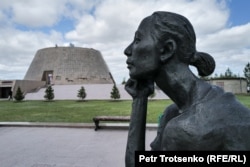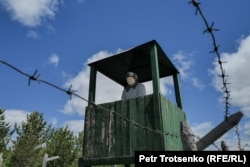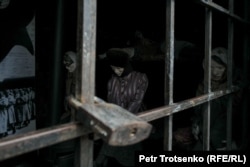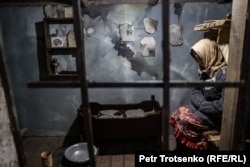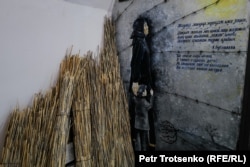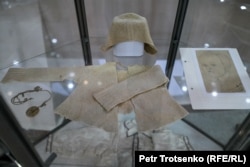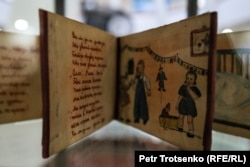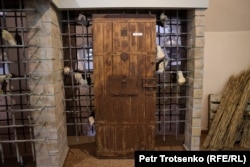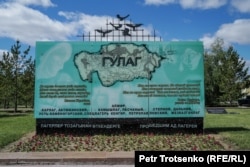Known by the acronym ALZHIR, the Aqmola camp for the "wives of traitors to the motherland" was a Stalin-era labor camp in the Aqmola region of Kazakhstan. In the 15 years that it was in operation -- from 1938 to 1953 -- nearly 18,000 women passed through it, some of whom never left.
*****
AQMOLA, Kazakhstan -- To get a sense of the bleak harshness, one should visit here during the winter months, when the snow-covered steppe blends into the thick gray sky and the frigid, stinging wind pierces deep into your bones. These were the conditions faced by the camp's initial prisoners when they arrived in the winter of 1938 at the height of Soviet dictator Josef Stalin's repressions.
Galina Stepanova-Klyuchnikova, a student at the Moscow Institute of Transport Engineers, was among the first prisoners to arrive. Following the arrest of her husband, she was condemned to five years of forced labor in Stalin's gulags, from 1938 to 1942.
She wrote of her harrowing experiences:
"The barracks, made of adobe, not yet dried, were filled by women from different cities. Most of them were from Moscow, but there were also from Ukraine, Belarus, and Georgia. The sight of them stunned me. They all had their heads shaved. The pitiful, scared women looked like ridiculous teenagers."
Their crime? Being in a relationship with "traitors to the Motherland," which made it sufficient grounds for them to also receive a prison sentence.
After her experience at the camp in Aqmola, Stepanova-Klyuchnikova was sent into exile in Petropavlovsk. In October 1956, following the historic 20th Congress of the Communist Party, which denounced the personality cult of Stalin, she was rehabilitated.
The Memorial Complex
In front of the museum, located in the village of Aqmol, three workers are struggling to attach a new banner to a roadside billboard with the inscription "ALZHIR Museum and Memorial Complex." The blustery wind causes the banner to whip back and forth as a metal ladder on which a man stands sways dangerously.
The museum is preparing for May 31: the Day of Remembrance for the Victims of Political Repression and Famine in Kazakhstan. It is a day when floral tributes are laid and vigils are held and visits to museums such as this are made.
The museum in Aqmola was not built on the original site of the camp -- on the shore of Lake Zhalanash -- but several kilometers away. Today, at the former site where so many suffered and some died, only reeds and trees stand.
The museum, a large, unsightly building lined with rough brown tiles in a brutalist style, is not a welcoming site. It instead opts to make its visitors feel uncomfortable.
In front of the entrance stands the 18-meter-high Arch Of Sorrow monument, which symbolizes a woman mourning her dead husband and lost children. It is customary to walk under the arch with your head bowed in memory of those who survived the torment in the camps.
Stepanova-Klyuchnikov wrote:
"The days flashed by, the nights flew, sometimes cold in winter, sometimes stuffy from the Kazakh dry wind in summer. Our whole life merged into a hopeless, difficult, gray day. In the morning, there is a general roll call in front of the barracks, then a ladle of thin porridge in the dining room. Work after breakfast. For dinner, the same barley porridge without any signs of fat, and again work 12-14 hours a day, seven days a week."
In front of the entrance to the museum stands a simple green tower from where a mannequin stands watch where one of Stalin's wagons delivered their next batch of women.
According to museum staff, upwards of 70 people would be crammed into each carriage. It is difficult to imagine how so many people could fit in such a small space.
Author Eugenia Ginzburg, who was also subjected to Stalin's repressions, wrote in her book Steep Route about her journey to the camp:
"I noticed that the carriage they squeezed me into is marked with the number seven. There are so many people crammed into it that it seems there will be nowhere to even stand. After all, the 'law' of the prison states that 'the tighter, dirtier, and hungrier they are, the rougher the convoy, and the greater the chance of survival.' So far, this has proven true."
Depictions of camp life form the basis of the museum's exhibition: a prisoner under interrogation, a prisoner at work, a prisoner next to a cradle in which a fake baby lies.
It is hard not to notice the impression it makes on the museum's visitors. Most rarely talk or take pictures with their phones; instead, they opt for silence, which is only broken by the voices of the guides.
"We have a lot of visitors here, especially foreigners and Russians," one of the museum employees said, before adding, "They come in groups, families, diplomatic delegations. There are also many Kazakhs, of course. Schoolchildren are often brought in when the program begins to study the history of the Soviet period."
As for the schoolchildren, the employee said that some look at the exhibits indifferently, while others try to joke, but nearly everyone is touched by what they experience.
"I can see it in their eyes," the employee said.
The Prison For Mothers
Women who were expecting or who had small children were housed in a separate barracks called the "Mother's House." The children were watched over by a prisoner nanny while the mothers were forced to work. During the camp's existence, 1,507 children were born in the camp. When they reached the age of 3, they were placed in orphanages.
Stepanova-Klyuchnikova recalled:
"A year of strict regime passed -- without letters, without parcels, without any news of freedom. And suddenly the whole camp was excited by an unusual event. A real letter with a stamp and postmark arrived. On the envelope, in a child's handwriting, was written 'City of Aqmol -- Prison For Mothers.' An 8-year-old girl wrote that after her mother and father were arrested; she was also arrested and put in an orphanage."
An exhibition of personal belongings that were donated to the museum by descendants is now on display.
Of note are the personal artifacts from children who lived in the camp: a simple cap, a vest, and a shirt. Prisoner Lotta Rice sewed them for her children from pieces of old women's underwear, which she exchanged for tobacco from fellow inmates.
On the top shelf stands a homemade folding book with an inscription on the cover: "To my son Kolya." Rice made this book using wooden planks and a wood-burning device. They say that this was the only toy her son had.
"Pooh-pooh, oh-oh-oh,
My little bunny is dying!
They brought him home
He turned out to be alive."
Kolya was born in 1946 at the camp in Karlag, at the time one of the largest gulags in the Soviet Union.
The boy survived, later moving from Kazakhstan to Germany, where he became Conrad Rice. In 2022, with a group of tourists, he visited the museum, where he told the staff the story of his life, about his childhood in the camp, and about how he had recorded the memories of his elderly mother.
Conrad Rice donated to the museum items that his mother sewed for him and his little sister, who died in the camp when she was 8 months old.
Behind The Door
During Stalin's terror, prisoners were subjected to brutal interrogations that could last up to eight hours, or until the victims collapsed.
"The entire interrogation system is designed for the moral, psychological, and physical exhaustion of those under investigation," wrote camp historian Anfisa Kukushkina.
The door at the pretrial detention center is another exhibit. Massive, rough, and securely put together, it is impossible to knock down. Behind these doors, no one could hear the screams of the prisoners.
Nearby stands a mirror wall with a fake lattice, which is held by dozens of hands. This is the installation called Shackles. The mirror canvases behind the bars reflect the visitor's barely recognizable features, momentarily transporting them beyond the line that runs between the present and the past. This is how the installation in the museum is explained.
Though the museum building is small, you can walk around its silent grounds for hours. Behind the museum stands a wall with the names of victims. During the 15 years of the camp's existence, an estimated 600 women died here.
Along the grounds, near the young trees that separate the museum from the busy highway, stands a monument titled Tears featuring a map containing the names of 11 camps located on the territory of Kazakhstan. Atop it are steel bars with birds soaring high into the sky behind and above.
The only sounds one hears are the many crows who live in these trees, busily feeding their young.
*****
Approximately 5 million people were banished to the gulags in Kazakhstan from the 1930s until 1959. It is estimated that over 1.1 million people died during the years of repression in the Soviet Union.
